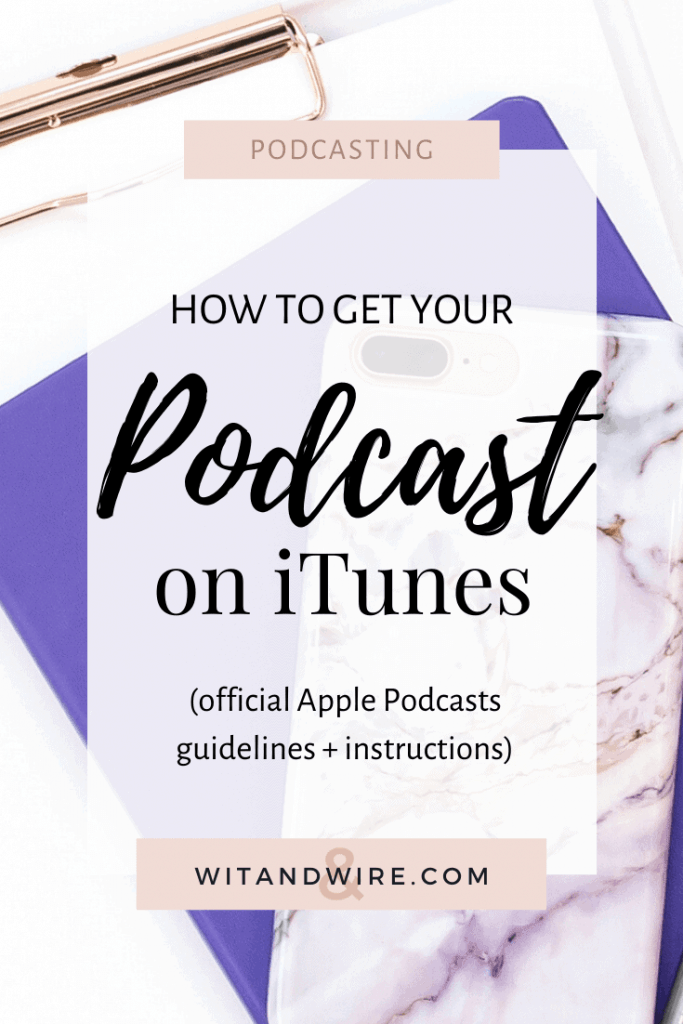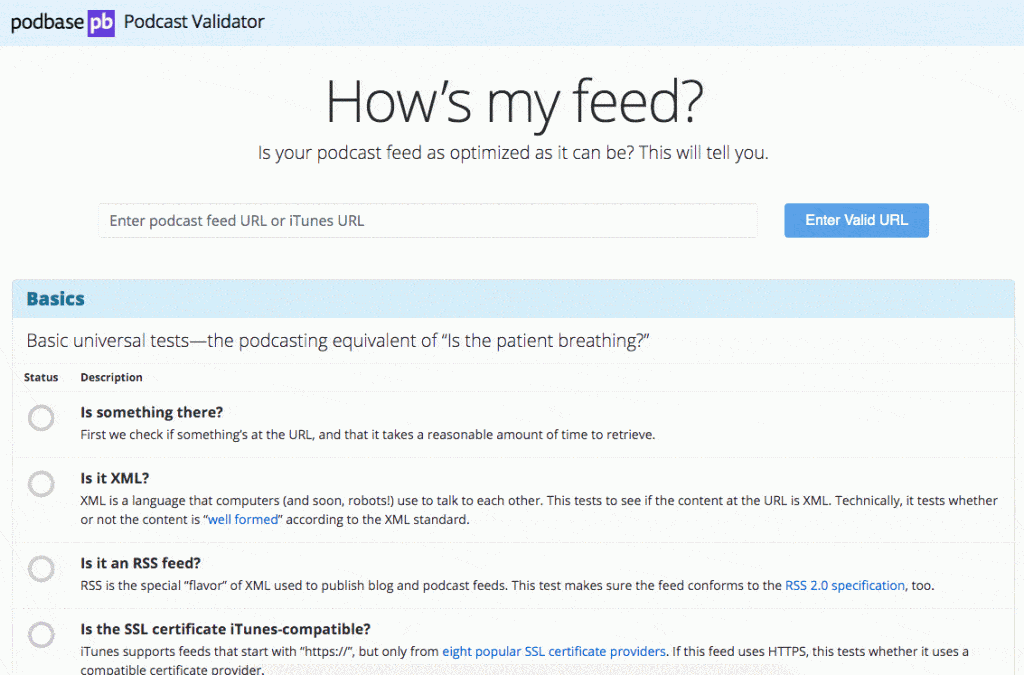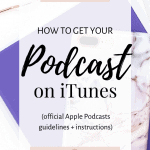As podcast popularity continues to rise, getting your podcast on Apple Podcasts (formerly iTunes) is as important as ever.
Even though there are more podcast listening apps than ever before – including Spotify, Stitcher, Google Podcasts, and Amazon – Apple Podcasts is still one of the most popular options worldwide. And in this guide, I’ll show you exactly how you can get your podcast approved on Apple Podcasts (for free).

The shift from podcasts on iTunes to Apple Podcasts
In 2012, Apple released their dedicated Podcasts app on the iPhone. Shortly after, the app became a default app on all iPhones.
This was a huge deal for podcasters because in the late 2000s, podcasting was still a pretty foreign concept to most listeners. So when you stumbled across a new show, the host had to spend a lot of energy just teaching people how to listen to their podcast.
Then in July 2019, Apple broke up with iTunes and decided to break it into three smaller apps, including Apple Podcasts.
Since then, they’ve continued to invest time and money into their listening experience. And with each new iOS release, Apple continues to make improvements that keep Apple Podcasts at the forefront of the podcast listening experience.
The best time to submit your podcast to Apple Podcasts
In a minute, I’ll walk you through the submission process step by step. But there’s one thing I want to cover first: timing.
What most people don’t realize is that approval isn’t instantaneous. (This is true not just for podcasts on iTunes, but for any directory or listening app.)
💡 Key Takeaway: Apple Podcasts typically takes 1-3 business days to approve new podcasts. But if you submit during a busy time, it may take longer.
This could affect your planning and promotion timeline for your launch. (In fact, the first time I launched a podcast, I didn’t realize that I’d have to wait. So I had to push my plans back by a week.)
But now that you know your approvals take time, I’d recommend giving all the apps 1-2 weeks of buffer time to process and approve your podcast.
Your timeline will look like this:
- Create your first few episodes
- Create your show description and podcast artwork (more below)
- Submit to Apple Podcasts and other directories when you’re ready to go live
In short, submitting your podcast to Apple Podcasts is the very last step before launch.
🎙️ Need a microphone? Choosing the right mic is one of the most important decisions you’ll make as a podcast host. Here are our recommendations for the best podcast microphones.
So if you’re ready, here’s how to do it. (If not, just Pin this post for later!)
The major requirements for podcasts on iTunes
Apple’s admin area for podcast hosts is called Apple Podcasts for Creators (formerly Podcasts Connect. (Here’s the full instruction area, but I’ll sum up the important parts below.)
Here’s the big thing; Apple won’t let you submit a show with no content. You need to have at least one episode to prove that your podcast is real.
Here’s the checklist of everything you’ll need to create before you submit to Apple Podcasts:
1. You need an Apple ID
If you’ve ever used iTunes or an iPhone in your life, you’ve already got an Apple ID.
But if not – or if you want to make a new one with your business or podcast email address – then you’ll need to start by creating an Apple ID.
Here are Apple’s instructions to create an Apple ID on the web on your desktop, which is my recommended method. There are also instructions for Mac & PC apps, so you have your choice.
2. Create your show and your RSS feed
Behind the curtain, all podcasts are RSS feeds of audio files (episodes). As a podcaster, one of the key tools you’ll need is your podcast hosting platform, which will automatically create your RSS feed on your behalf.
💡 New to RSS feeds? Check out our full article on RSS feeds here.
There’s another big component to your RSS feed, and it’s called metadata. When you build your podcast in your hosting platform, you’ll need to include the following information, at a minimum:
- Podcast title
- Podcast description
- Podcast category
- Podcast artwork
- At least one actual episode. (I recommend a short 30-60 sec trailer.)
Once you find your RSS feed from your podcast host, you’ll be ready to go to the next step. (This shouldn’t be hidden; on almost every podcast host, this is very easy to find in your show settings.)
🎙️ Best podcast hosting platforms: Here’s our up-to-date list of the best podcast hosting platforms, including special savings for Wit & Wire readers.
3. A note on podcast artwork
Apple is extremely particular about your podcast artwork, which is the image that represents your show across its platform. (This is the image your listeners will see by default when they’re listening to your show.)
Here are their exact requirements for all podcast artwork:
- Size: square; minimum 1400 x 1400 pixels and maximum 3000 x 3000 pixels
- Resolution: 72 dpi
- File type: JPEG or PNG
- Colorspace: RGB
- Show artwork must be original and can’t contain any of the following:
- Blurry, misaligned, mismatched, or pixelated images
- Explicit language
- Placeholder images
- The Apple Inc., Apple Podcasts, or iTunes Store logos
- The terms Apple Inc., Apple Podcasts, Apple Music, iTunes Store, or iTunes
- Visual representation of Apple hardware
- References to illegal drugs, profanity, or violence
As I mentioned before, your artwork will actually be part of the RSS feed’s metadata when you create your podcast in your hosting platform. But these are the requirements that Apple will look for when they validate your feed.
4. Content requirements
Apple’s content guidelines boil down to this:
- Don’t be graphic or explicit unless you’ve marked your show as explicit
- Don’t reference anything illegal or violent
- Don’t pirate content
- Don’t use Apple’s intellectual property
How to submit your podcast to Apple Podcasts
If your podcast is fully ready to go – with your description, first episode, and artwork all uploaded in your podcast hosting platform – then the actual submission process is very straightforward.
All you need is your RSS feed.
There are three steps:
1. Test your podcast
First, let’s see if your RSS feed is functioning properly. Apple recommends using Podbase’s Podcast Validator to test your feed. You’ll copy/paste your RSS feed into their website and wait for the green light:

2. Submit your podcast
Once your RSS feed checks out, you have two options.
You can either submit your podcast to Apple via your podcast hosting platform, or you can submit it directly for Apple Podcasts for Creators.
If you want to submit directly to Apple, here are your instructions:
- You can log in here: https://podcastsconnect.apple.com
- On the Sign In page, enter your Apple ID and password. (Don’t have an Apple ID or want to create a new one under a different email address? Click here: Create Apple ID)
- Accept the Terms of Service agreement, if applicable.
- Go to My Podcasts > Submit New. (You’ll see a plus sign.)
- Submit your RSS feed and click Validate.
3. Await approval
If you get the green light, hit submit! Now it’s just a waiting game. Within 1-3 business days, your podcast should be approved (unless it’s a particularly busy time of year.)
Conclusion
Submitting your podcast to Apple Podcasts is a one-time task that all podcasters must complete before launching. It’s open to anyone, as long as you meet the content criteria.
But if you’re still working on your podcast launch, and you’re looking for more support or guidance, I recommend our free training, how to create & launch a podcast (for beginners). I hope it helps!

Melissa Guller is the founder of Wit & Wire, where we help everyday experts become profitable course creators. She previously worked full-time for Ramit Sethi, Teachable, and General Assembly. Today, she shares simplified tech tutorials and modern marketing strategies through our blog, YouTube, and Wit & Wire Weekly newsletter

